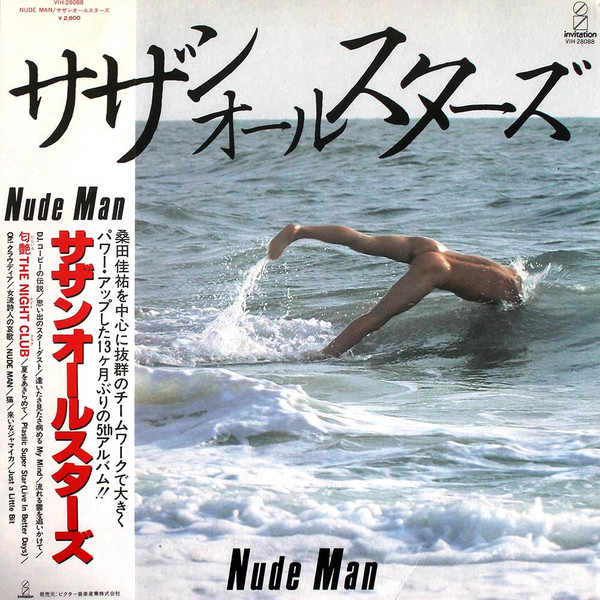
THE HISTORY
Sugar Babe was a soft rock band formed in Tokyo, Japan in 1973 and split up in 1976. The core of the band featured the pre-solo debut of Tatsuro Yamashita (山下達郎 ), Taeko Ohnuki(大貫妙子), & Kunio Muramatsu (村松邦男). The group made its live performance debut in 1973 at the farewell concert for the rock group Happy End. Now there were a lot of one-off bands during the 70s’, however, what made them stand out was their music style. They were perhaps one of the first Japanese rock bands to use the Major 7ths & Broken chords, which made the music extremely different from the pop of that time period. While their contemporaries were hard rockers, Sugar Babe focused on playing melodic, well-crafted tunes heavily influenced by American pop from the ’60s and ’70s and soul music. Coupled with romanticized lyrics about city life, all these elements lead to the creation of their debut album, SONGS, which laid the groundwork for what would later be known as City Pop.
 |
FROM THE LEFT: Kunio Muramatsu, Taeko Ohnuki, Kikuo Wanikawa, Tatsuro Yamashita, Akihiko Noguchi
|
The initial debut lineup of the band was Yamashita, Ohnuki and Kunio on vocals (and many instruments), Kikuo Wanikawa(鰐川己久男)on bass, Makoto Kimura (木村誠) on percussions, and Akihiko Noguchi(野口明彦)on drums. Although there were changes made during the actual recording of the album and the final year of Sugar Babe's existence, which included the inclusion of Ginji Ito(伊藤銀次)on guitar, and Kikuo & Akihiko Being replaced by Yuasa Uehara (上原裕) & Jiro Terao (寺尾次郎) on drum & bass respectively. Sugar Babe also had some veteran help from the likes of former Happy End front-man Eiichi Ohatki, who was the producer & mixer of the album, and Fumiyo Nunoya on backing vocals, who was the lead singer of the hard rock group, Blues Creation. The cover of the album was designed by Tatsuya Kaneko (金子辰也), whose art is a recreation of a photo of two women from a Photography Book published in 1954 called Women of Paris, by Nico Jesse & André Maurois.
 |
FROM THE LEFT: Tatsuro Yamashita, Taeko Ohnuki, Yuata Uehara, Kunio Muramatsu, & Jiro Terao
|
The recording of the album started October 28, 1974, and lasted until March 7th of 1975. SONGS was released on the 25th of April, 1975, as the flagship release of Ohtaki's Niagara label, which was a sub-label of Elec Records, one of the first Japanese independent labels. The reception of the band was mostly negative from the mainstream, outside of the niche crowd of college students, which apparently included a young, pre-debut Mariya Takeuchi. With no other bands of the same style, they received a lot of irrational criticism and silly slander. In an interview with Red Bull Academy, Ohunki recalls one concert where Sugar Babe played, the audience started throwing trash and bottles at them, being screamed at and called “a bunch of cicadas” whenever they sang. The band broke up in 1976, due in part to the bankruptcy of their record label, and also the fact they grew apart musically. Yamashita, Muramatsu, and Ohnuki went on to have long and successful careers and would use much of the material they had initially written for a second Sugar Babe album, for their respective debut albums, Ohnuki with Grey Skies (1976), Muramatsu with Green Waters (1983), and Yamashita with Circus Town (1976).
 |
Sugar Babe Alongside their producer, Eiichi Ohtaki
|
 |
Sugar Babe in Live
|
- SHOW: This almost Broadway Revue-style intro serves as the perfect beginning to the album, the highlight being the vocal breakdown at the end reminiscent of the Four Seasons.
- DOWNTOWN: And here it is, what’s basically ground zero for literally all City Pop music. Combining the bright surf rock-esque guitars, with the funky drums & clavinet beat reminiscent of the Isley Brothers, to create the perfect anthem for a lively Saturday night.
- Mirage Town (Shinkirou no Machi /蜃気楼の街): Taeko Ohnuki and her piano take the spotlight this time to give us a more mellow look at being in the city.
- World of Wind (Kaze no Sekai/ 風の世界): Another one of Taeko’s introspective songs, this time about feeling lonely in an empty city.
- Always Sighs (Tameiki Bakari/ためいきばかり): A bouncy tune about morning hangover blues written by Kunio Muramatsu that's equal parts bubble gum pop & country rock.
- As Usual (Itsumo Doori /いつも通り): A short mid-tempo upbeat tune about someone going about their unchanging life in the big city. The highlight being the awesome string arrangements during the chorus section.
- Lovely Melody (Suteki na Melody/すてきなメロディー): Probably the shortest and most unique song in the album. It’s an upbeat honky-tonk pop tune built around the chords of Pachelbel's Canon. It also features another interesting vocal breakdown, this time with...goat noises???
- Somehow Today (Kyou wa Nan daka/今日はなんだか): Probably the 2nd most iconic song Yamashita sings on this album. A high-tempo soft rock tune that almost reaches power ballad territory.
- The Rain Has Filled The Palms of My Hands (Ame wa Te no Hira ni Ippai/雨は手のひらにいっぱい): City Pop’s first official resort pop song, about a rainy day in the city. Complete with arrangements that are equal parts, B.J. Thomas & Phil Spector.
- Days Gone "60's Dream" (Sugi Sarishi Hibi/過ぎ去りし日々): The only acoustic track on the album by Yamashita himself. A nostalgic & sad song about a high-school relationship that didn’t last.
- SUGAR: The finale of the album that feels more like a jam session than a complete song. Still enjoyable nonetheless with its more Latin-based arrangements. The lyrics also feature a nice reference to "Sugar Town" by Nancy Sinatra.
 |
Track List from the Anniversary Release
|
THE VERDICT
Production: ⭐⭐⭐⭐
Vocals:⭐⭐⭐⭐
Arrangement:⭐⭐⭐
Aesthetic:⭐⭐⭐
Memorability: ⭐⭐⭐
Composition:⭐⭐⭐⭐
Listening to SONGS is a lot like getting a party pack of potato chips, you technically get a lot of variety, but each bag of chips is too small to enjoy on its own and you may not like every brand of chips in the package. It’s very clear that each songwriter on this album has their particular music preferences, but the lack of full potential keeps the album from having the fluidity the listener needs for a fully enjoyable trip. Yamashita is trying to take us to California, while Ohnuki wants to go to Europe, and Muramatsu is lost somewhere in the Midwest. Even compared to their closest contemporary, Sentimental City Romance (which debuted the same year), have a more unified sound despite delving into the west coast, country rock, and funk, all on the same album.
In its defense, however, SONGS is one of the lesser offenders of this issue and Almost all of the individual songs are still iconic on their own merits. 雨は手のひらにいっぱい would be the first song to showcase Ohtaki’s own brand of “Wall of Sound” production, which he would later develop for his magnum opus, A Long Vacation. And tunes like Ohunki’s いつも通り & Yamashita’s Downtown would set the standard for the future sound of City Pop, both instrumental and lyrical.
 |
I think people who are more accustomed to the late 70s' & 80s' City Pop might feel a bit alienated from this album since its sound leans less towards Steely Dan and TOTO, and more towards Carol King, The Rascals & The 5th Avenue Band (who was quoted by Ohnuki as a major influence). But past that, I think SONGS by Sugar Babe is worth a listen just on the merit of it being ground zero for City Pop, and how it changed the landscape of Pop & Rock music in Japan. On top of that SONGS prominently changed the landscape of pop & rock forever, influencing many artists to come. According to singer-songwriter Toshiki Kadomatsu (角松 敏生), Sugar Babe was a monumental influence on him as he listened to it relentlessly in his youth. Going on about how he & other high-school students who were well versed in the 3 chord progression of rock, couldn't catch up with the more complex riffs & chords Sugar Babe was doing at all. Pop artists Eiko Miyagawa (宮川榮子), a.k.a. EPO made her career debut as one of the “Three Daughters of RCA” with a whole single & album dedicated to Sugar Babe’s signature song, Downtown.

In a landscape that was dominated by acts like Pink Lady, Hiromi Go, Momoe Yamaguchi, & Hideki Saijo, fellow Kayo historian J-Canuck put it best when he says Sugar Babe came in and pierced through that landscape like a bolt of lightning, and truly stands out as something unique and revolutionary.
 |
| Sugar Babe Reunion! (Minus Tatsuro Yamashita 😟 ) |



No comments:
Post a Comment